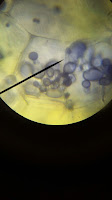INTRODUCTION:
Denaturation is a process in which proteins or nucleic acids lose the quaternary, tertiary and secondary structure that is present in their native state.
OBJECTIVE:
1.Study de relation between the structure and the function of proteins
2.Understand how temperature, pH and salinity affect to the protein structure.
MATERIALS:
-2x250mL beaker
-4 test tube
-10mL Pipet
-Knife
-Glass marking pen
-Potato
-Distilled water
-Hydrogen Peroxide
-NaCl
-HCl
CATALASE ACTIVITY:
Catalase is a common enzyme found in nerly all-living organisms exposed to oxygen. It catalyzes the composition of hydrogen peroxide to water and oxygen. It is a very important enzyme in protecting the cell from oxidative damage and preventing the accumulation of hydrogen peroxide.
In this experiment we are going to test the catalase activity in different environment situations. We are going to mesure the rate of enzyme activity under various conditions, such as different pH values and temperature. We will mesure catalase activity by observing the oxygen gas bubble when water is destroyed.
Prepare 30mL of water 10% in beaker with a pipet
Prepare 30mL of HCl 10% in beaker
Prepare 30mL of NaCl 50% in beaker
Peel a fresh potato tuber and cut the tissue in five cubes of 1cm3
Weight them and equale the mass
Label the test tubes
Immerse 10 minutes your piece of potato inside HCl beaker
Immerse 10 minutes another piece of potato inside NaOH beaker
Boil another piece of potato
With a mortal, mash up the third piece of potato
Prepare 5 test tubes as indicated below
Add 5mL of watwe 10% in each test tube
TUBE
|
TREATMENT
|
1
|
Raw potato
|
2
|
Boiled potato
|
3
|
Potato with HCl treatment
|
4
|
Potato with NaCl treatment
|
5
|
Mashed up potato
|
The independent variable is the test tube and the dependent variable is the bubble weight. In this photo we can see this:
QUESTIONS:
1. How did the temperature of the potato affect the activity of catalase?
Temperature denaturate the catalase.
2. How did the change of the pH of the potato affect the activity of catalase?
The change of the Ph denaturate the catalase.
3. In wich potato treatment was catalase the most active? Why do you think this was?
In the mashed potato, because we had broken the cells.
4. An experiment was performed to test the effect of temperature and pH on the activity of Enzyme X. The following data was collected during the experiment:
a) What is the optimum pH of enzyme X? 8 (maximum activity)
b) What is the optimum temperature of enzyme X? 20 (maximum activity)
c) Why do you think enzyme X has low activity at a pH of 10? Because has been denatured
























